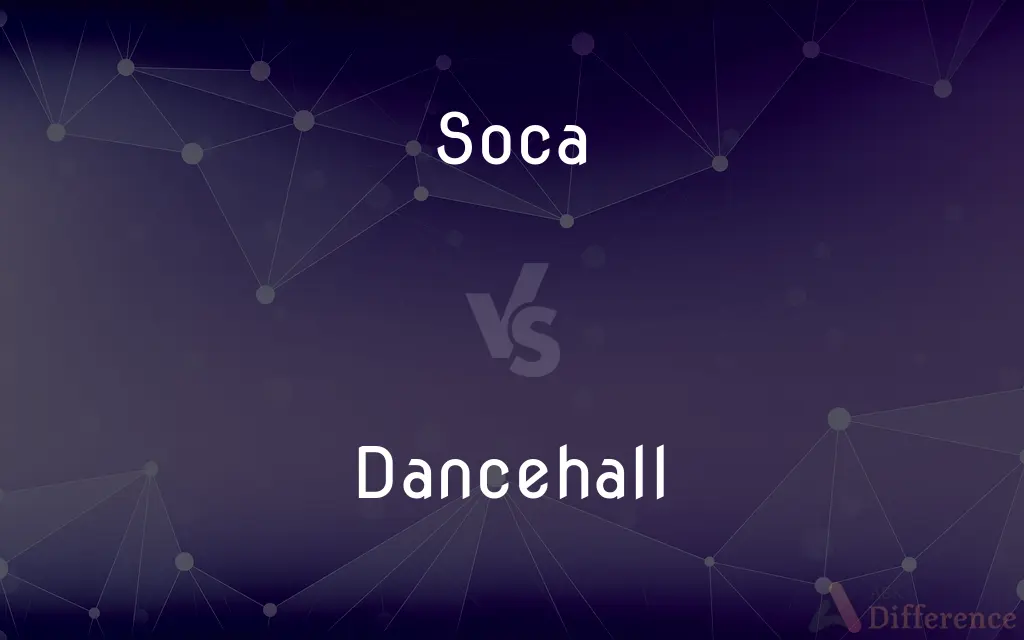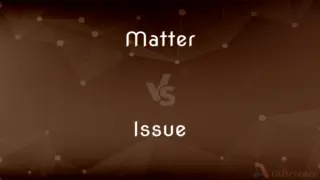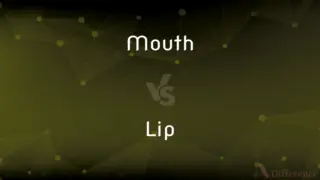Soca vs. Dancehall — What's the Difference?
By Tayyaba Rehman & Urooj Arif — Updated on March 8, 2024
Soca music is upbeat and rooted in calypso, designed to evoke joy and dancing, while dancehall is a genre of Jamaican music with a focus on rhythm and explicit storytelling.

Difference Between Soca and Dancehall
Table of Contents
ADVERTISEMENT
Key Differences
Soca, originating in Trinidad and Tobago, is a derivative of calypso music with a high-energy beat intended to inspire dancing and celebrate Caribbean culture. On the other hand, dancehall, born in Jamaica, emphasizes rhythmic patterns known as 'riddims' and often features deejaying or toasting over tracks, focusing on social and political commentary, as well as party themes.
The rhythm of soca is characterized by its fast tempo and fusion with Indian musical instruments such as the dholak and tabla, reflecting the multicultural heritage of Trinidad and Tobago. Whereas dancehall music, while also rhythmic, tends to have a heavier bass and a more digital sound, influenced by the electronic advancements in music production during the 1980s.
Soca often focuses on themes of joy, festivity, and unity, serving as a soundtrack for Carnival celebrations throughout the Caribbean. Dancehall lyrics can vary widely but are known for their explicit content, storytelling, and addressing of social issues, making the genre a voice for the marginalized in Jamaican society.
Soca music is traditionally associated with Carnival and its related events, playing a crucial role in the festivities, including competitions like Soca Monarch. In contrast, dancehall music is deeply intertwined with Jamaican dance culture, inspiring unique dance moves and fashion, and is a staple in dancehall parties and street dances.
Despite their differences, both genres have evolved to incorporate elements from other musical styles, such as R&B, hip hop, and reggae, demonstrating their adaptability and influence on global music scenes. However, soca tends to maintain a more consistent focus on creating a party atmosphere, while dancehall's versatility allows it to traverse themes from party anthems to political commentary.
ADVERTISEMENT
Comparison Chart
Origin
Trinidad and Tobago
Jamaica
Musical Influence
Calypso, Indian musical instruments
Reggae, electronic music
Themes
Joy, festivity, unity
Social commentary, party themes, storytelling
Rhythm and Tempo
Fast tempo, emphasis on beats
Heavier bass, digital sound
Cultural Significance
Integral to Carnival celebrations
Integral to dance culture and social commentary
Compare with Definitions
Soca
Serves as a celebration of Caribbean culture.
Soca is more than music. it's a vibrant expression of our heritage.
Dancehall
Inspires unique dance moves and fashion.
Dancehall culture is known for its distinctive dances and style.
Soca
A genre of Caribbean music that combines calypso with Indian rhythms.
The carnival was alive with the sound of soca music.
Dancehall
Often discusses social issues through explicit lyrics.
The dancehall song provided commentary on societal struggles.
Soca
Integral to Trinidad and Tobago's Carnival.
Soca music competitions are a highlight of Carnival season.
Dancehall
A genre of Jamaican music with a focus on rhythm and DJ commentary.
Dancehall music dominated the party, with its infectious beats.
Soca
Known for its fast tempo and joyful vibes.
Soca music always gets everyone on the dance floor.
Dancehall
Characterized by its digital production and heavy bass.
Modern dancehall tracks feature digital effects and deep bass lines.
Soca
Often features brass instruments and electronic beats.
The soca track blended trumpets with synthesizers for a festive sound.
Dancehall
Reflects the voice of the marginalized in Jamaica.
Dancehall music often speaks to the experiences of Jamaica's urban youth.
Soca
A style of music, originating in the West Indies, that is a blend of soul and calypso.
Dancehall
Dancehall is a genre of Jamaican popular music that originated in the late 1970s. Initially, dancehall was a more sparse version of reggae than the roots style, which had dominated much of the 1970s.
Soca
(music genre) A genre of music that originated in Trinidad and Tobago in the early 1970s and developed into a range of styles during the 1980s and after which primarily includes influences of African and Indian rhythms.
Dancehall
Or dance hall A building or part of a building with facilities for dancing.
Dancehall
A style of reggae music that incorporates hip-hop and rhythm and blues elements. Also called ragga.
Dancehall
(countable) A public hall for dancing.
Dancehall
A genre of Jamaican dance music derived from dub and reggae.
Common Curiosities
How do the rhythms of soca and dancehall music compare?
Soca features a fast tempo with a focus on beats, whereas dancehall emphasizes heavier bass and digital sound.
Do soca and dancehall influence other music genres?
Both genres have influenced and incorporated elements from other musical styles, including R&B, hip hop, and reggae.
What is soca music?
Soca is a genre of Caribbean music originating from Trinidad and Tobago, known for its upbeat tempo and fusion of calypso with Indian rhythms.
How do soca and dancehall artists typically engage with their audiences?
Soca artists often engage through energetic performances that encourage dancing, while dancehall artists may use their music to connect on social and political levels.
What defines dancehall music?
Dancehall is a genre of Jamaican music characterized by its rhythm, explicit storytelling, and significant influence on dance and fashion.
Can soca and dancehall be traced back to specific origins?
Yes, soca originated in Trinidad and Tobago, while dancehall originated in Jamaica.
What role does dance play in dancehall music?
Dance is a crucial element of dancehall culture, inspiring unique moves and styles that are integral to the genre's identity.
How do soca and dancehall differ in themes?
Soca often celebrates joy, festivity, and unity, while dancehall explores a wider range of themes, including social commentary and partying.
Are there specific cultural significances associated with each genre?
Soca is integral to Carnival celebrations, especially in Trinidad and Tobago, while dancehall is deeply connected to Jamaican dance culture and social issues.
How do soca and dancehall concerts differ?
Soca concerts are often part of larger Carnival celebrations with a focus on dancing and festivity, while dancehall concerts can vary from energetic dance parties to more intimate performances that emphasize lyrical content.
What instruments are commonly used in soca music?
Soca music frequently uses brass instruments, electronic beats, and Indian musical instruments like the dholak and tabla.
How do soca and dancehall reflect Caribbean identity?
Both genres showcase the rich cultural diversity and creativity of the Caribbean, though through different musical expressions and themes.
Are soca and dancehall music popular outside the Caribbean?
Yes, both genres have gained international popularity, influencing global music scenes and artists.
What is the global impact of soca and dancehall music?
Soca and dancehall have both contributed to the global music landscape by influencing various genres and artists around the world.
How do soca and dancehall address social issues?
While soca primarily focuses on themes of joy and unity, dancehall frequently addresses social issues, making it a voice for the marginalized in society.
Share Your Discovery

Previous Comparison
Matter vs. Issue
Next Comparison
Mouth vs. LipAuthor Spotlight
Written by
Tayyaba RehmanTayyaba Rehman is a distinguished writer, currently serving as a primary contributor to askdifference.com. As a researcher in semantics and etymology, Tayyaba's passion for the complexity of languages and their distinctions has found a perfect home on the platform. Tayyaba delves into the intricacies of language, distinguishing between commonly confused words and phrases, thereby providing clarity for readers worldwide.
Co-written by
Urooj ArifUrooj is a skilled content writer at Ask Difference, known for her exceptional ability to simplify complex topics into engaging and informative content. With a passion for research and a flair for clear, concise writing, she consistently delivers articles that resonate with our diverse audience.
















































